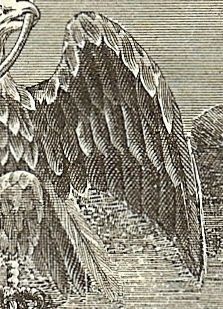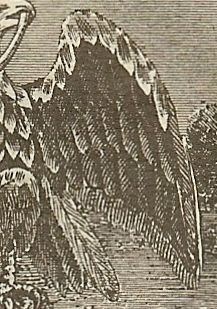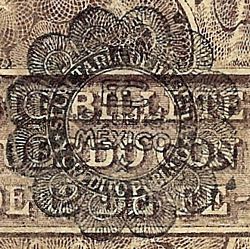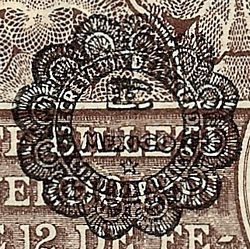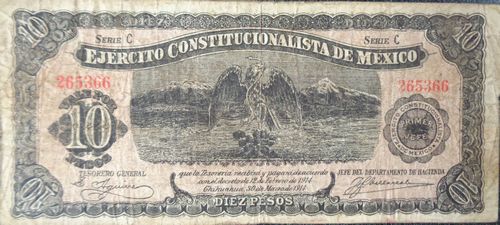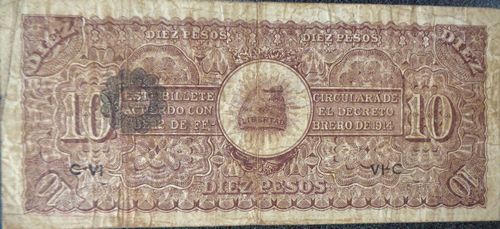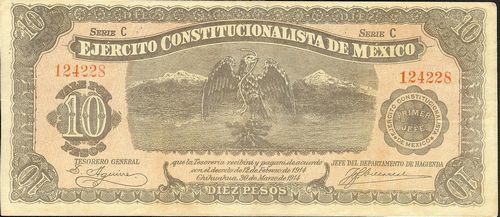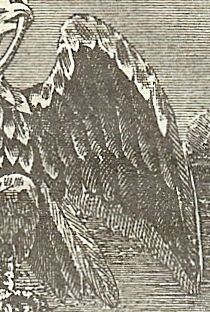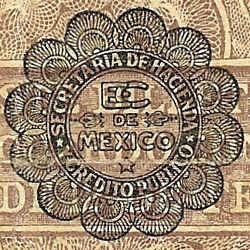Counterfeit $10 Ejército Constitucionalista notes
There are fewer references to counterfeit $10 notes but it is possible to identify a few types.
Counterfeit $10 Ejército Constitucionalista Type 1
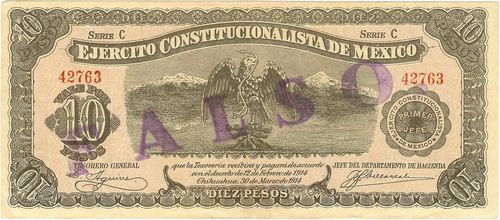
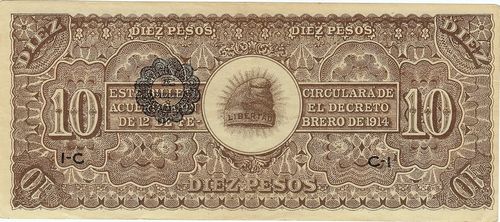
Counterfeit $10 notes without Villarreal’s initials apparently appeared in Chihuahua in January 1915La Convención, 6 January 1915.
| GENUINE | COUNTERFEIT |
|---|---|
|
|
|
To this can be added:
| different pattern of wavy lines in underprint | |
|
|
|
|
|
|
These are known with control letters I-C C-I.
A notice from January 1915 states that a $10 note without a monogram had appeared in Chihuahua whilst a notice published in Baja California in 1915ABCS, Gobernación, vol. 642, exp. 150 lists the following two characteristics:
| GENUINE | COUNTERFEIT |
|---|---|
| No monogram | |
| The design of the vignette is perfectly clear and detailed | Appears smudged |
There are also counterfeit notes with these features but with the monogram included: see Type 4 below.
Counterfeit $10 Ejército Constitucionalista Type 2
A late notice of September 1915 lists these characteristics of a counterfeit $10 note.
| GENUINE | COUNTERFEIT |
|---|---|
| the wavy line is less distinct in the top corners | |
| the stars over the word ‘DIEZ’ are very badly printed | |
| on the reverse, the word ‘LIBERTAD’ on the Phrygian cap is indistinct and the printing smudged |
Counterfeit $10 Ejército Constitucionalista Type 3
On 31 January 1916 the Presidente Municipal of San Luis Potosí reported a counterfeit $10 Ejército Constitucionalista C 265366 C-VI VI-CASLP, Ayuntamiento 1916.11 exp. 18 letter Presidente Municipal, San Luis Potosí to Juan Barragán, Jefe de Hacienda, 31 January 1916; confirmation that indeed false, 31 January 1916. The details were:
| GENUINE | COUNTERFEIT |
|---|---|
| poor thick printing | |
| stars over DIEZ indistinct |
so this could be the same as this Type 3.
Counterfeit $10 Ejército Constitucionalista Type 4
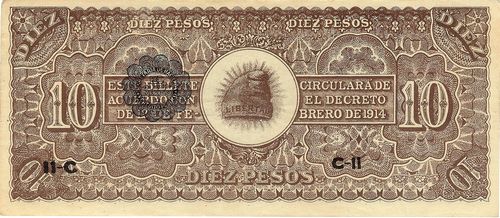
In October 1915 Urbano Treviño was sent by the Tesoreria General de la Nacion to the Jefatura de Hacienda in Monterrey to clarify which notes were fake and which notACoah, Fondo Siglo XX, 1915, caja 26, folleto 5, exp. 1, letter from Jefe de Hacienda, 5 October 1915. Treviño went on to Coahuila where he reported finding eleven counterfeit $10 notes (numbers 33606, 33640, 34289, 41452, 66754, 67411, 70382, 133849, 172795, 182690 and 182693). Instructions from the Jefatura de HaciendaACoah, Fondo Siglo XX, 1914, caja 8, folleto 4, exp. 13 in Coahuila listed the following characteristics:
|
Shading of vertical lines under the right wing (sombras a rayas verticales debajo del ala derecha) |
|
| Smooth signature (firma lisa) | |
|
|
No accent on ‘MEXICO’ in the Secretaría seal |
These are known in a variety of inks and with the following control letters: C-I I-C and II-C C-II. They are known with genuine validations and with counterfeit Nogales resellos.
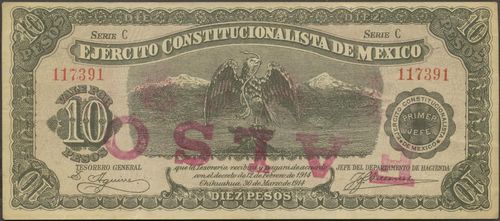
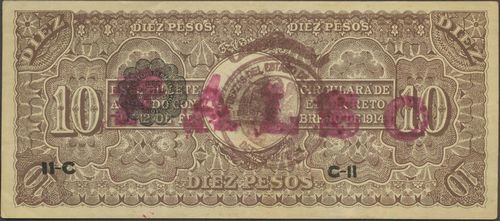
Counterfeit $10 Ejército Constitucionalista Type 4a
A variant has the above features of Type 4 but the contour of the left-hand mountain is flatter. The example has control letters II-C C II.
Counterfeit $10 Ejército Constitucionalista Type 5
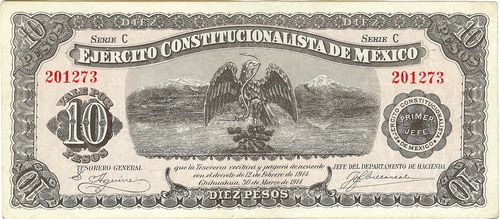
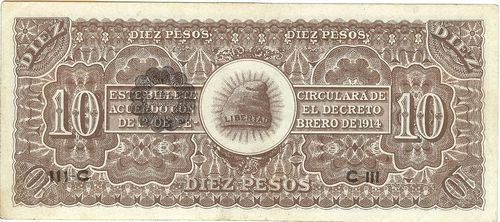
This type also has the flatter left-hand mountain and the defective seal but the eagle's wing is correct.
| GENUINE | COUNTERFEIT |
|---|---|
Counterfeit $10 Ejército Constitucionalista Type 6
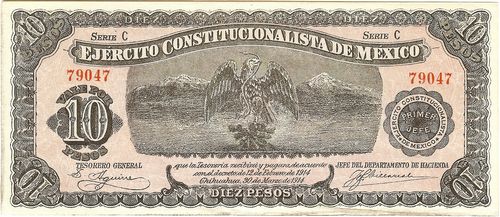
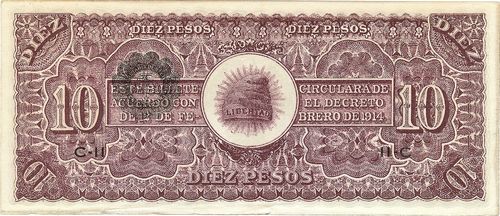
This has a poorly executed 'promise to pay'.
| GENUINE | COUNTERFEIT |
|---|---|
|
|
On 7 June 1915 it was reported that a widespread falsification had been discovered in Veracruz. Apparently León Rast (sic, also Raast), a Russian from Puebla, well known as a swindler and attempted arms dealerBorn in Russia in 1867, Rasst came to Mexico in early 1880s and settled in Puebla with his Swiss-born wife Luisa. He bcame a trader and, through his companies, Rasst, Headen y Compañía and A. M. Davis y Compañía, sold anything from semi-precious stones to liquor to German merchants via New York middlemen. He was listed as a Jewish business who owned the textile factory “La Prusia.” and in 1913 claimed to be “Russian General Consul Puebla Mexico” - an office that did not exist. The Bureau of Investigation Agent Berliner wrote in 1918 “Rasst is a Russian Jew of the lowest type and is a very slippery customer. Agent is personally acquainted with him …”
Leon Rasst was one of the financiers of the arms of the Ypiranga. From Agent Scully’s report, in all likelihood Raast had been sent to arrange shipping of the arms, which Abraham Ratner had ordered months before. For that purpose Huerta gave him $12,000 (the freight money), which apparently Rasst did not disperse. According to Meyer (Michael C. Meyer, Huerta, a political portrait, University of Nebraska Press, 1972), because of the U.S. arms embargo León Raast, the Russian vice-consul in Mexico City, on behalf of Huerta, travelled to New York in November 1913, purchased a cargo of arms from the Colt Automatic Arms Company in Hartford, Connecticut, and arranged for the shipment of these and some additional arms which had already been secured by other means. In order to avoid the embargo restrictions the arms were not sent directly to Mexico but went first to Odessa, Russia, and then to Hamburg, Germany, where they were placed aboard the S.S. Ypiranga, a steamer of the Hamburg-American line. In early April the Ypiringa lifted anchor for Veracruz with a huge cargo of arms and ammunition in its hold. This incident led to the U.S. invasion of Veracruz. However, Heribert von Feilitzsch, (Heribert von Feilitzsch, In Plain Sight: Felix A. Sommerfeld, Spymaster in Mexico, 1908 to 1914, Henselstone Verlag LLC, 2012) claims Meyer is wrong., was apprehended with 36,000 $10 Ejército Consitucionalista notes. It seems he had produced two million in Galveston, Texas, but was discovered by the Mexican and American authorities before he could achieve muchEl Radical, 7 June 1915. In May 1915 the Russian vice consul had told the Secretaría de Gobernación that the facts were that Raast was in business with a Sr. Adolfo Hegewisch, manager of the Compañía Marítima de Veracruz. Some time previously Hegewisch had received a consignment of Rasst’s counterfeit notes, from Galveston, and used them in various transactions, including giving $36,000 to the Casa Viya Hermanos Sucrs., of Veracruz. The business refused to accept them because they were all suspiciously brand new $10 notes. Finally, they did so when the Secretaría de Fomento certified them as genuine. A little later the Secretaría de Gobernación del Estado raided the Casa Viya Hermanos and confiscated about $5,000 of these $36,000. In spite of all its efforts to retrieve the other notes which it had already put into circulation the Casa could only recover $21,000. It was likely that Rasst had moved his operations to PueblaPeriódico Oficial de Puebla, Tomo XCVI, Núm. 16, 8 June 1915.
On 12 June Carranza wrote to Rasst in the Russian Embassy in Washington, D.C. in response to a query four days earlier that the money recovered by the police had turned out to be counterfeit and could not be returnedCEHM, Fondo XXI-4, telegram Carranza to Rasst, Russian Embassy, Washington, 12 June 1915.
However, Raast reappeared in September in an incident that showed counterfeit notes could have "currency" in the United States. In September 1915 the Mount Vernon Brewery in Baltimore City was purchased for $32,935.00, credited by a mortgage of $12,500.00 and cash of $1,000.00, leaving a balance of $19,435.00, which was to be paid under the contract in $299,000 (face value) Carrancista Constitutional Mexican currency, which was valued at $29,900.00 US currency. The purchasers guaranteed that the money was genuine but it turned out to be “spurious, false and counterfeit”. The case was taken to law, and finally decided by the Maryland Court of Appeals on 9 December 1919Raast v. Morris, 135 Md. 243 (1919).
On 15 June 1915 Luis Pruneda, the Inspector at the government printing works at Veracruz, reported that they knew of five types of counterfeit $10 Ejército Constitucionalista notesCEHM, Fondo XX1, carpeta 43, legajo 4641.



